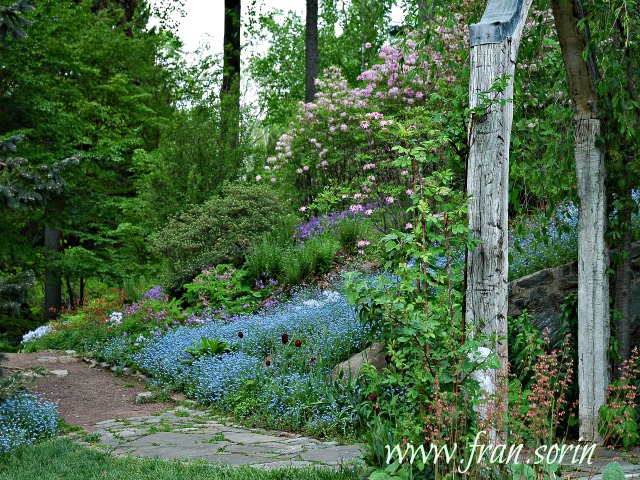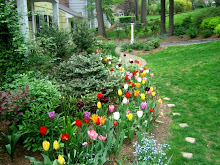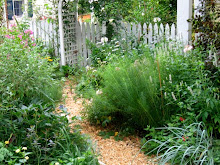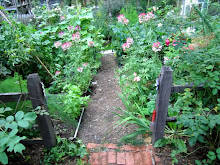Welcome to Heirloom Gardener
Saturday, October 17, 2009
Saturday, September 26, 2009
Thursday, September 10, 2009
Milkweed Seeds in the Bird Garden
Posted by
Julia Erickson
at
4:25 PM
5
comments
![]()
![]()
Labels: Self Seeders
Wednesday, September 09, 2009
Red and Yellow Milkweed in the Bird Garden
Posted by
Julia Erickson
at
4:23 PM
2
comments
![]()
![]()
Labels: Self Seeders
Tuesday, September 08, 2009
Yellow Milkweed in the Bird Garden
Posted by
Julia Erickson
at
9:39 PM
3
comments
![]()
![]()
Labels: Self Seeders
Tuesday, July 07, 2009
Monday, May 18, 2009
Winter Aconite Seedheads: how Winter Aconite self-seeds

Posted by
Julia Erickson
at
11:07 PM
4
comments
![]()
![]()
Labels: Bulbs and Tubers, Propagation and Seeds, Self Seeders
Thursday, April 30, 2009
Spring Ephemeral Highlight: Self-Seeding Virginia Bluebells
Virginia bluebells highlight the spring ephemeral season for me. As I wrote in my post about them last year, they continue to slowly and delightfully self-seed throughout the garden.
 I eagerly await the beautiful purple mouse ear leaves which break the surface in early March. The leaves quickly grow into large glaucous green leaves.
I eagerly await the beautiful purple mouse ear leaves which break the surface in early March. The leaves quickly grow into large glaucous green leaves..
Posted by
Julia Erickson
at
6:00 PM
3
comments
![]()
![]()
Labels: Self Seeders, Spring Garden
Wednesday, March 18, 2009
The Winter Aconite Continue to Self Seed

Posted by
Julia Erickson
at
9:18 PM
3
comments
![]()
![]()
Labels: Bulbs and Tubers, Self Seeders, Winter Garden
Tuesday, October 21, 2008
Autumn Beauty: Metamorphosis of the Blackberry Lily from Blooms to Seedheads
As a follow-up to last year's post on the Blackberry Lily (Belamcanda chinensis), I made sure to capture the delicate flowers this year in addition to the attractive seedpods and seedheads: "The blackberry lily blooms at the end of July over several weeks. The flowers and seed heads make great cut flowers for arrangements. These lovely seedheads develop in autumn." The first picture shows a close-up of the bloom.
"The blackberry lily blooms at the end of July over several weeks. The flowers and seed heads make great cut flowers for arrangements. These lovely seedheads develop in autumn." The first picture shows a close-up of the bloom. The second picture shows the plant in between the blooms and the immature green seedpods.
The second picture shows the plant in between the blooms and the immature green seedpods.
The third picture shows the plant shedding the now brown and papery seedpods to reveal the black seedheads from which they derive their name.
"Resist temptation: do not eat them. The seedheads persist into winter. They will drop and produce more plants the following spring. Although it does self seed, it is not prolific and gives a more natural look to the garden. The seedling take one to two years to reach blooming size. Note: they are deer resistant."
Posted by
Julia Erickson
at
9:49 PM
1 comments
![]()
![]()
Labels: Autumn Garden, Lilies, Seed Heads, Self Seeders
Thursday, September 18, 2008
Spider Flowers (Cleome)
As a follow-up to my earlier post about self-seeders, here are some additional pictures of this season's spider flowers (cleome) that better capture their beauty and complexity. "Spider flowers (cleome) are big and are sometimes hard to plant in the garden without them looking like stiff soldiers. But once spider flowers are allowed to self seed, it transforms them. They look very natural growing through other plants and often to different heights depending on where they are.
"Spider flowers (cleome) are big and are sometimes hard to plant in the garden without them looking like stiff soldiers. But once spider flowers are allowed to self seed, it transforms them. They look very natural growing through other plants and often to different heights depending on where they are. They also have a range of color. In the front of Goldberry Hill, I only allow violet ones. In the Egg Garden, I try to keep more white than pink. In the Children's Garden, they are mostly pink because my daughter loves pink. Also, as the first plants become leggy, plants from seed which germinated later reach up to cover up the old bare stalks."
They also have a range of color. In the front of Goldberry Hill, I only allow violet ones. In the Egg Garden, I try to keep more white than pink. In the Children's Garden, they are mostly pink because my daughter loves pink. Also, as the first plants become leggy, plants from seed which germinated later reach up to cover up the old bare stalks."
Posted by
Julia Erickson
at
9:20 PM
3
comments
![]()
![]()
Labels: Propagation and Seeds, Self Seeders
Monday, February 25, 2008
Volunteers: Hardy Annual and Biennial Self Seeders
Hardy volunteers are a welcome gift from the garden. I have several reseeding annuals and biennials which each year enrich the garden. These plants which spring up where they please provide necessary filler and continuity within the borders. The advantage of volunteers is they weave themselves naturally into the garden. By doing so they hold the other plants together and give it a more relaxed feel. Also, they sometimes pop up where I would not have thought of planting them or could not have planted them. Reseeders also fill any holes in the plantings offering a sense of abundance. I have two types of volunteers: accent plants and unifiers.
 Amaranthus 'Hopi' is a very tall, red stemmed plant which I grow in the Cutting Garden, Egg Garden, and Long Border (it is pictured here between the Egg Garden and the Front Border). I bought Hopi from Annie's Annuals three years ago. It is a generous self seeder which requires thinning out of the seedlings in the spring since I only want about five or six plants. The birds love the seeds so I usually don't worry about too many seedlings. I also cut off some of the flowers as the seeds mature to keep for fall decorations.
Amaranthus 'Hopi' is a very tall, red stemmed plant which I grow in the Cutting Garden, Egg Garden, and Long Border (it is pictured here between the Egg Garden and the Front Border). I bought Hopi from Annie's Annuals three years ago. It is a generous self seeder which requires thinning out of the seedlings in the spring since I only want about five or six plants. The birds love the seeds so I usually don't worry about too many seedlings. I also cut off some of the flowers as the seeds mature to keep for fall decorations. When the amaranthus is young, I transplant some into containers or to other spots where I want them to grow. I keep more in the cutting garden for arrangements and to be dug up at a later date to fill in any holes which develop.
Sunflowers are always welcome. Due to the birds, I only get a few of these, but they are greatly appreciated.
 Inspired by Mottisfont Abbey (http://www.nationaltrust.org.uk/main/w-vh/w-visits/w-findaplace/w-mottisfont/), I have white foxglove in the Rose Garden. Most of the seedlings which I don't thin out grow in situ, but others are moved to the Cutting Garden. I try to keep the foxglove in the Rose Garden white, so any which bloom non-white are cut for arrangements. If you don't like having the spent flower stem left up, it works quite well to cut the stalk and lay it on the ground. I find that once the upper most flowers have bloomed the seeds from the bottom ones are mature. Cutting the stems also has the added advantage of stimulating the plant to produce more flowering side shoots.
Inspired by Mottisfont Abbey (http://www.nationaltrust.org.uk/main/w-vh/w-visits/w-findaplace/w-mottisfont/), I have white foxglove in the Rose Garden. Most of the seedlings which I don't thin out grow in situ, but others are moved to the Cutting Garden. I try to keep the foxglove in the Rose Garden white, so any which bloom non-white are cut for arrangements. If you don't like having the spent flower stem left up, it works quite well to cut the stalk and lay it on the ground. I find that once the upper most flowers have bloomed the seeds from the bottom ones are mature. Cutting the stems also has the added advantage of stimulating the plant to produce more flowering side shoots. Sweet William, a biennial, is another heirloom plant which is extremely easy to grow, but often overlooked (pictured here under the wisteria). The flowers of the older varieties like Holborn's Glory are fragrant and make a nice edging in the front of a border. I have these in the Cutting Garden and Long Border.
Sweet William, a biennial, is another heirloom plant which is extremely easy to grow, but often overlooked (pictured here under the wisteria). The flowers of the older varieties like Holborn's Glory are fragrant and make a nice edging in the front of a border. I have these in the Cutting Garden and Long Border. Queen Anne's Lace is confined to the Cutting Garden as it is great mixed with other cut flowers. It took me several years to get it to grow which leads me to believe that the freshness of the seed makes a great difference in establishing it. Since then, I have had no problems keeping it. With fresh seed it reseeds quite a lot; after all, it is a weed to many. To prevent it from going beyond its welcome, I do not allow it into other areas of the garden; I cut a lot of it; and I thin it out when I have too much.
Queen Anne's Lace is confined to the Cutting Garden as it is great mixed with other cut flowers. It took me several years to get it to grow which leads me to believe that the freshness of the seed makes a great difference in establishing it. Since then, I have had no problems keeping it. With fresh seed it reseeds quite a lot; after all, it is a weed to many. To prevent it from going beyond its welcome, I do not allow it into other areas of the garden; I cut a lot of it; and I thin it out when I have too much. Spider flowers (cleome) are big and are sometimes hard to plant in the garden without them looking like stiff soldiers. But once spider flowers are allowed to self seed, it transforms them. They look very natural growing through other plants and often to different heights depending on where they are. They also have a range of color. In the front of Goldberry Hill, I only allow violet ones. In the Egg Garden, I try to keep more white than pink. In the Children's Garden (pictured), they are mostly pink because my daughter loves pink. Also, as the first plants become leggy, plants from seed which germinated later reach up to cover up the old bare stalks.
Spider flowers (cleome) are big and are sometimes hard to plant in the garden without them looking like stiff soldiers. But once spider flowers are allowed to self seed, it transforms them. They look very natural growing through other plants and often to different heights depending on where they are. They also have a range of color. In the front of Goldberry Hill, I only allow violet ones. In the Egg Garden, I try to keep more white than pink. In the Children's Garden (pictured), they are mostly pink because my daughter loves pink. Also, as the first plants become leggy, plants from seed which germinated later reach up to cover up the old bare stalks.
Posted by
Julia Erickson
at
12:45 AM
12
comments
![]()
![]()
Labels: Propagation and Seeds, Self Seeders
Sunday, December 02, 2007
Blackberry Lily Seedheads
 I love splashes of orange in the garden. My blackberry lily has small orange flowers with red dots. There is another cultivar that is yellow. They do not look like lilies. Unfortunately, I don't think I took a picture of the flowers. I have to remember to take some pictures of them next year.
I love splashes of orange in the garden. My blackberry lily has small orange flowers with red dots. There is another cultivar that is yellow. They do not look like lilies. Unfortunately, I don't think I took a picture of the flowers. I have to remember to take some pictures of them next year.
The blackberry lily blooms at the end of July over several weeks. The flowers and seed heads make great cut flowers for arrangements.
These lovely seedheads develop in autumn. The first picture shows the immature pods. The outside becomes brown and papery. They break open to reveal the luscious blackberry seedheads. Resist temptation: do not eat them. The seedheads persist into winter. They will drop and produce more plants the following spring.
Although it does self seed, it is not prolific and gives a more natural look to the garden. The seedling take one to two years to reach blooming size. Note: they are deer resistant.
Note: they are deer resistant.
Posted by
Julia Erickson
at
11:53 PM
0
comments
![]()
![]()
Labels: Autumn Garden, Lilies, Seed Heads, Self Seeders, Winter Garden
Search Heirloom Gardener
Labels
- About Blogging
- Annuals/Biennials and Perennials
- Autumn Garden
- Books and Movies
- Botanical Gardens
- Bulbs and Tubers
- Children's Garden
- Chrysanthemum
- Clematis
- Container Gardening
- Crocus tommasiniasus roseus
- Cut and Forced Flowers
- Cutting and Rose Gardens
- Dahlias
- Deep Thoughts About Gardening
- Egg Garden
- Fences Arbors Walls and Paths
- Floral arrangements
- Front Border
- Fun Stories About Gardening
- Garden Bloggers' Bloom Day
- Garden Bloggers' Design Workshop
- Garden Planning
- Gardening Blogs
- Gardening Tools and Structures
- Gardening with Children
- Goldberry Hill
- Heirloom and Organic Food
- Hibiscus
- Holidays
- Hydrangeas
- Japanese Beautyberry
- Lilies
- Mixed Borders
- New Jersey / Local Interest
- Nurseries
- Online Gardening Resources
- Peonies
- Pest Control
- Picture This Photo Contest
- Piet Oudolf
- Poppies
- Propagation and Seeds
- Pruning and Maintenance
- Roses
- Seed Heads
- Self Seeders
- Shrubs
- Spring Garden
- Summer Garden
- Trees
- Wildlife in the Garden
- Winter Garden
- Zinia


























